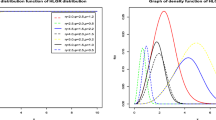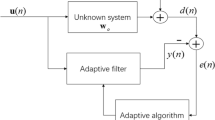Abstract
The presence of both the fading and shadowing effects (also called composite multipath/shadowed fading) is often encountered in a realistic radio propagation scenario, thus, making it necessary to consider the simultaneous effect of fading and shadowing on the received signal. The multipath effect is captured using models such as Rician, Nakagami-m, Weibull distribution and shadowing effect is modeled using Log-normal distribution. In this paper we present the closed-form expression of composite (Weibull/log-normal shadowed) fading using the efficient tool proposed by Holtzman. Using this result, the closed-form expression of combined (time-shared) shadowed/unshadowed fading is presented. The performance measures of fading communication systems such as probability density function of signal to noise ratio, amount of fading, outage probability (Pout) and channel capacity are analyzed and expressed in closed form.












Similar content being viewed by others
References
Simon, M. K., & Alouini, M. S. (2004). Digital communication over fading channels (2nd ed.). New York: Wiley-IEEE Press.
Khandelwal, V., & Karmeshu, (2014). A new approximation for average symbol error probability over log-normal channels. IEEE Wireless Communications Letters, 3(1), 58–61.
Hashemi, H. (1993). Impulse response modeling of indoor radio propagation channels. IEEE Journal on Selected Areas in Communications, 11(7), 967–978.
Hansen, F., & Mano, F. I. (1977). Mobile fading—Rayleigh and lognormal superimposed. IEEE Transactions on Vehicular Technology, 26(4), 332–335.
Al-Ahmadi, S., & Yanikomeroglu, H. (2010). On the approximation of the generalized-K distribution by a gamma distribution for modeling composite fading channels. IEEE Transactions on Wireless Communications, 9(2), 706–713.
Sagias, N. C., Karagiannidis, G. K., Bithas, P. S., & Mathiopoulos, P. T. (2005). On the correlated Weibull fading model and its applications. Proceedings of IEEE Vehicular Technology Conference, 4, 2149–2153.
Hashemi, H. (1993). The indoor radio propagation channel. Proceedings of the IEEE, 81, 943–968.
McConoughey, S. R., Adawi, N. S., Bertoni, H. L., Child, J. R., Daniel, W. A., Dettra, J. E., et al. (1988). Coverage prediction for mobile radio systems operating in the 800/900-MHz frequency range. IEEE Transactions on Vehicular Technology, 37(1), 3–72.
Sagias, N. C., Zogas, D. A., Karagiannidis, G. K., & Tombras, G. S. (2004). Channel capacity and second-order statistics in Weibull fading. IEEE Communications Letters, 8(6), 377–379.
El Bouanani, F., Ben-Azza, H., & Belkasmi, M. (2012). New Results for the Shannon channel capacity over generalized multipath fading channels for MRC diversity. EURASIP Journal on Wireless Communications and Networking, 2012, 336.
Al-Hussaini, E. K., Al-Bassiouni, A. M., Mouradand, H. M., & Al-Shennawy, H. (2002). Composite macroscopic and microscopic diversity of sectorized macro cellular and microcellular mobile radio systems employing RAKE receiver over Nakagami fading plus lognormal shadowing channel. Wireless Personal Communications, 21(3), 309–328.
Jakes, W. C. (1994). Microwave mobile communication (2nd ed.). Piscataway, NJ: IEEE Press.
Abdi, A., & Kaveh, M. (1999). On the utility of Gamma PDF in modeling shadow fading (slow fading). Proceedings of IEEE Vehicular Technology Conference, 3, 2308–2312.
Bithas, P. S. (2009). Weibull-gamma composite distribution: Alternative multipath/shadowing fading model. IEEE Electronic Letters, 45(14), 749–751.
Laourine, A., Alouini, M.-S., Affes, S., & Stephenne, A. (2009). On the performance analysis of composite multipath/shadowing channels using the G-distribution. IEEE Transactions on Communications, 57(4), 1162–1170.
Atapattu, S., Tellambura, C., & Jiang, H. (2010). Representation of composite fading and shadowing distributions by using mixtures of gamma distributions. In Proceedings IEEE WCNC, pp. 1–5.
Miticand, A., & Jakovljevic, M. (2007). Second-order statistics in Weibull-lognormal fading channels. In: Proceedings of TEKSIKS, Serbia, Nis.
Alouini, M. S., & Smith, G. (1999). A unified approach for calculating error rates of linearly modulated signals over generalized fading channels. IEEE Transactions on Communication, 47(9), 1324–1334.
Lutz, E., Cygan, D., Dippold, M., Dolainsky, F., & Papke, W. (1991). The land mobile satellite communication channel: Recording, statistics, and channel model. IEEE Transactions on Vehicular Technology, 40(2), 375–386.
Barts, R. M., & Stutzman, W. L. (1992). Modeling and simulation of mobile satellite propagation. IEEE Transactions on Antennas and Propagation, 40(4), 375–382.
Lieblein, J. (1955). On moments of order statistics from the Weibull distribution. The Annals of Mathematical Statistics, 26(2), 330–333.
Holtzman, J. M. (1992). A simple, accurate method to calculate spread multiple access error probabilities. IEEE Transactions on Communications, 40(3), 461–464.
Khandelwal, Karmeshuand V. (2013). On the applicability of average channel capacity in log-normal fading environment. Wireless Personal Communications, 68(4), 1393–1402.
Gradshteyn, I. S., & Ryzhik, I. M. Table of integrals, series, and products (7th edn). Academic Press Elsevier.
The Wolfram functions site. [Online]. Available: http://functions.wolfram.com.
Mathai, A. M., Saxena, R. K., & Haubold, H. J. (2010). The H-function: Theory and applications. Berlin: Springer.
Coelho, C. A., & Arnold, B. C. (2012). Instances of the Meijer-G and Fox-H functions and of the distribution of the product of independent beta random variables with finite representation. AIP Conference Proceedings, 1479, 1133. doi:10.1063/1.4756348.
Author information
Authors and Affiliations
Corresponding author
Appendix
Appendix
Proof of (35)
As per Generalization of classical Meijer’s integral from two G functions ([25], /07.34.21.0012.01)
Using the result of (38), the integral of (37) can be easily written as
For any a, b, c, where \(\text{Re} (b) > 0\,\&\, m \ge 1;\) ([26], /Eq. 1.66)
Using (40), (6) can be easily written as
Using (42), we obtain a simplified form of (41) in terms of Meijer-G function expressed as
Rights and permissions
About this article
Cite this article
Singh, R., Soni, S.K., Raw, R.S. et al. A New Approximate Closed-Form Distribution and Performance Analysis of a Composite Weibull/Log-Normal Fading Channel. Wireless Pers Commun 92, 883–900 (2017). https://doi.org/10.1007/s11277-016-3583-3
Published:
Issue Date:
DOI: https://doi.org/10.1007/s11277-016-3583-3




